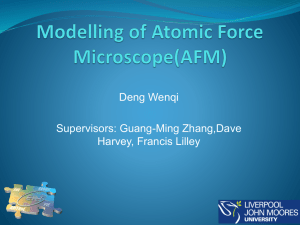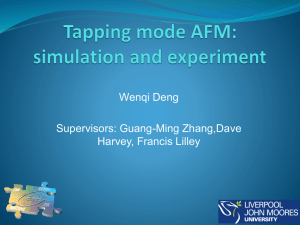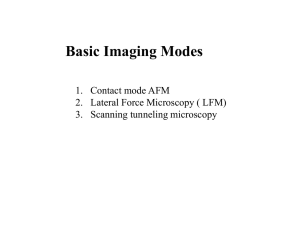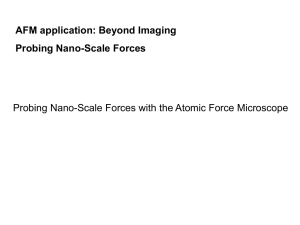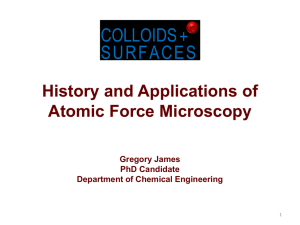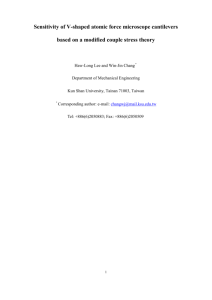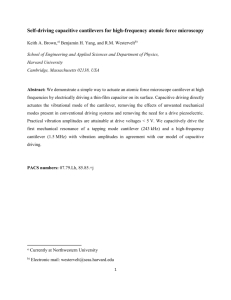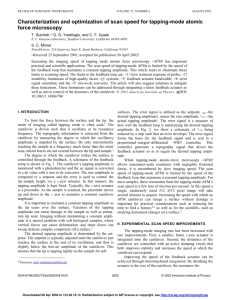High-speed atomic force microscopy in liquid T. Sulchek,a) R. Hsieh
advertisement
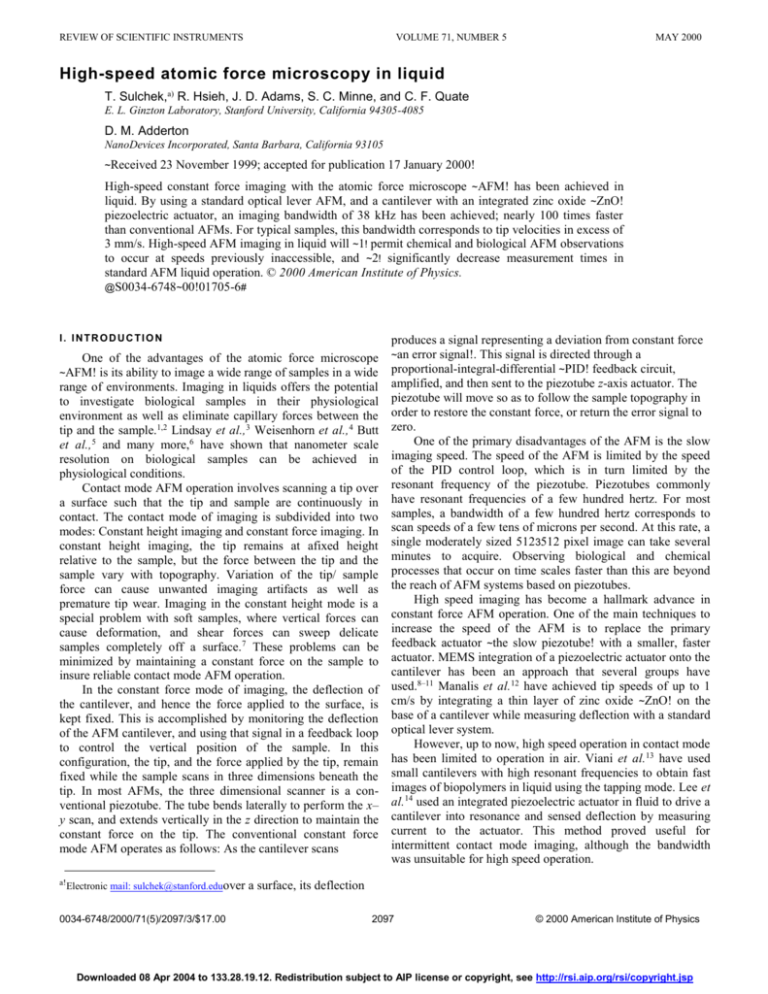
REVIEW OF SCIENTIFIC INSTRUMENTS VOLUME 71, NUMBER 5 MAY 2000 High-speed atomic force microscopy in liquid T. Sulchek,a) R. Hsieh, J. D. Adams, S. C. Minne, and C. F. Quate E. L. Ginzton Laboratory, Stanford University, California 94305-4085 D. M. Adderton NanoDevices Incorporated, Santa Barbara, California 93105 ~Received 23 November 1999; accepted for publication 17 January 2000! High-speed constant force imaging with the atomic force microscope ~AFM! has been achieved in liquid. By using a standard optical lever AFM, and a cantilever with an integrated zinc oxide ~ZnO! piezoelectric actuator, an imaging bandwidth of 38 kHz has been achieved; nearly 100 times faster than conventional AFMs. For typical samples, this bandwidth corresponds to tip velocities in excess of 3 mm/s. High-speed AFM imaging in liquid will ~1! permit chemical and biological AFM observations to occur at speeds previously inaccessible, and ~2! significantly decrease measurement times in standard AFM liquid operation. © 2000 American Institute of Physics. @S0034-6748~00!01705-6# I. INTRODUCTION One of the advantages of the atomic force microscope is its ability to image a wide range of samples in a wide range of environments. Imaging in liquids offers the potential to investigate biological samples in their physiological environment as well as eliminate capillary forces between the tip and the sample.1,2 Lindsay et al.,3 Weisenhorn et al.,4 Butt et al.,5 and many more,6 have shown that nanometer scale resolution on biological samples can be achieved in physiological conditions. Contact mode AFM operation involves scanning a tip over a surface such that the tip and sample are continuously in contact. The contact mode of imaging is subdivided into two modes: Constant height imaging and constant force imaging. In constant height imaging, the tip remains at afixed height relative to the sample, but the force between the tip and the sample vary with topography. Variation of the tip/ sample force can cause unwanted imaging artifacts as well as premature tip wear. Imaging in the constant height mode is a special problem with soft samples, where vertical forces can cause deformation, and shear forces can sweep delicate samples completely off a surface.7 These problems can be minimized by maintaining a constant force on the sample to insure reliable contact mode AFM operation. In the constant force mode of imaging, the deflection of the cantilever, and hence the force applied to the surface, is kept fixed. This is accomplished by monitoring the deflection of the AFM cantilever, and using that signal in a feedback loop to control the vertical position of the sample. In this configuration, the tip, and the force applied by the tip, remain fixed while the sample scans in three dimensions beneath the tip. In most AFMs, the three dimensional scanner is a conventional piezotube. The tube bends laterally to perform the x– y scan, and extends vertically in the z direction to maintain the constant force on the tip. The conventional constant force mode AFM operates as follows: As the cantilever scans ~AFM! a! Electronic mail: sulchek@stanford.eduover 0034-6748/2000/71(5)/2097/3/$17.00 produces a signal representing a deviation from constant force ~an error signal!. This signal is directed through a proportional-integral-differential ~PID! feedback circuit, amplified, and then sent to the piezotube z-axis actuator. The piezotube will move so as to follow the sample topography in order to restore the constant force, or return the error signal to zero. One of the primary disadvantages of the AFM is the slow imaging speed. The speed of the AFM is limited by the speed of the PID control loop, which is in turn limited by the resonant frequency of the piezotube. Piezotubes commonly have resonant frequencies of a few hundred hertz. For most samples, a bandwidth of a few hundred hertz corresponds to scan speeds of a few tens of microns per second. At this rate, a single moderately sized 5123512 pixel image can take several minutes to acquire. Observing biological and chemical processes that occur on time scales faster than this are beyond the reach of AFM systems based on piezotubes. High speed imaging has become a hallmark advance in constant force AFM operation. One of the main techniques to increase the speed of the AFM is to replace the primary feedback actuator ~the slow piezotube! with a smaller, faster actuator. MEMS integration of a piezoelectric actuator onto the cantilever has been an approach that several groups have used.8–11 Manalis et al.12 have achieved tip speeds of up to 1 cm/s by integrating a thin layer of zinc oxide ~ZnO! on the base of a cantilever while measuring deflection with a standard optical lever system. However, up to now, high speed operation in contact mode has been limited to operation in air. Viani et al.13 have used small cantilevers with high resonant frequencies to obtain fast images of biopolymers in liquid using the tapping mode. Lee et al.14 used an integrated piezoelectric actuator in fluid to drive a cantilever into resonance and sensed deflection by measuring current to the actuator. This method proved useful for intermittent contact mode imaging, although the bandwidth was unsuitable for high speed operation. a surface, its deflection 2097 © 2000 American Institute of Physics Downloaded 08 Apr 2004 to 133.28.19.12. Redistribution subject to AIP license or copyright, see http://rsi.aip.org/rsi/copyright.jsp 2098 Rev. Sci. Instrum., Vol. 71, No. 5, May 2000 Sulchek e t al . FIG. 3. The closed loop transfer function of a ZnO cantilever, showing both amplitude and phase. With a margin in phase of 45 degrees, the imaging bandwidth is 38 kHz. FIG. 1. A schematic diagram for an AFM with an integrated piezoelectric actuator operating in liquid. The laser beam travels through the Plexiglas fluid cell, through the drop of liquid, and is reflected off the back of the cantilever into a split photodiode. A meniscus holds the liquid in place between the fluid cell and the sample. circuiting through the fluid. Several materials for passivation were used including spray coated Teflon, poly~methylmethacrylate! electron resist, and poly-dimethylsiloxane ~PDMS! elastomer.16 We found the best results to be ob- II. EXPERIMENT A schematic of the system used for this work is shown in Fig. 1. The silicon cantilever consists of a piezoelectric ZnO/ silicon bimorph. This bimorph forms the integrated actuator. The actuation occurs when a voltage is applied to the ZnO electrodes. The electric field expands or contracts the ZnO in proportion to the field; this creates stress between the piezoelectric and the silicon which is relieved by bending. The device used here has been described previously.15 During imaging, the cantilever is bent to follow the sample topography by applying a voltage to the ZnO electrodes that is proportional to the tip–sample force signal, as detected with an optical lever. The voltage signals are sent from the PID control amplifier to the cantilever holder, through a coaxial cable. The holder connects to the cantilever’s die through wire bonds. On the cantilever die, the wire bonds connect to thin film metal traces that extend to the ZnO actuator. A drop of liquid is inserted between the sample and the fluid cell so that the cantilever is completely immersed in the liquid. The ZnO actuator, the traces along the cantilever die, and the wire bonds from the die to the cantilever holder all must be passivated to protect the electrical signals from short FIG. 2. The transfer function of a freely vibrating ZnO cantilever in both air and water. The resonance is both damped and shifted to a lower frequency by the more viscous liquid environment. The Q changes from 110 to 3 and the frequency shifts from 56 to 35 kHz. The drive amplitude was 100 mV peak to peak, and the photodiode was filtered to a 1 MHz bandwidth. FIG. 4. Two high speed images in liquid. ~a! is a one micron scan of the surface of gold taken at a tip speed of 0.8 mm/s ~scan rate of 400 Hz!. The grains of gold have a height of approximately 5 nm and a lateral dimension of approximately 50 nm. ~b! shows an image of a grating with a 10 micron pitch, taken at a tip speed of over 3 mm/s ~scan rate of 55 Hz!. Imaging times for these 5123512 pixel images were approximately 1 and 10 s, respectively. Downloaded 08 Apr 2004 to 133.28.19.12. Redistribution subject to AIP license or copyright, see http://rsi.aip.org/rsi/copyright.jsp Rev. Sci. Instrum., Vol. 71, No. 5, May 2000 tained by passivation with the PDMS elastomer. The elastomer was applied by dipping the holder, die, and the cantilever’s actuator directly into the elastomer. Micromanipulators were used to ensure that the entire actuator region was covered, while leaving the tip region uncovered. We found the passivation to hold up well in both pure water and ionic solutions, as long as the elastomer completely covered the actuator region. I I I . R E S U L T S AN D D I S C U S S I O N Figure 2 shows the transfer function of the freely vibrating ZnO cantilever in air and in water. In air, the resonant frequency is 56 kHz with a Q of 110. In liquid, we expect a lower resonant frequency due to the increased damping effect of water.17 In liquid the resonance drops to 35 kHz and the Q to 3. A particularly advantageous result from using an integrated actuator in liquid is that the system’s response shows none of the spurious peaks associated with external drives.18 The bandwidth of the system is determined by the actuator’s ability to follow a modulation of the setpoint while the tip is in contact with a surface. In Fig. 3 we plot the closed loop frequency response of the ZnO cantilever in feedback. When we set the phase margin at 45 degrees, the bandwidth of the system is 38 kHz, almost 100 times that of a piezotube ~typically 600 Hz!. The minimum detectable distance is 0.3 Å in a 12 kHz bandwidth; showing no loss of resolution for the high speed system. Two high speed images taken in water are shown in Figs. 4~a! and 4~b!. The images were taken by raster scanning the sample using a 1 in. long piezotube. Figure 4 ~a! is a one micron scan of the surface of gold. The scan rate was 400 Hz corresponding to a tip speed of 0.8 mm/s. The grains of gold, with a height of under 5 nm, are approximately 50 nm across. This high resolution ~5123512 pixels! image was acquired in just over one second. Figure 4 ~b! is a 200 nm grating with a 10 mm pitch taken with a scan size of 30 microns at a scan rate of 55 Hz ~3 mm/s tip speed!. For images containing 200 lines, a scan rate of 400 Hz allows two frames to be acquired each second. At this refresh rate, we were able to center and zoom in on a single feature with real time feedback. Although our servo loop will oper-ate with faster tip speeds, a mechanical resonance in our x – y scanner limits the scan rate. The ability to acquire several images every second allows the possibility of real-time nanometer scale biological and chemical imaging. AFM in liquid 2099 ACKNOW LEDGM ENTS The authors would like to thank Jim Zesch for all of his help. One of the authors ~J.D.A.! acknowledges the support of a NSF graduate fellowship, another author ~D.M.A.! acknowledges support from NSF DMI-9903522. This work was supported by the Defense Advanced Research Projects Agency and the Semiconductor Research Corporation. 1 B. Drake, C. B. Prater, A. L. Weisenhorn, S. A. Gould, T. R. Albrecht, C. F. Quate, D. S. Cannell, H. G. Hansma, and P. K. Hansma, Science 243, 1586 ~1989!. 2 A. L. Weisenhorn, P. K. Hansma, T. R. Albrecht, and C. F. Quate, Appl. Phys. Lett. 54, 2651 ~1989!. 3 S. M. Lindsay, L. A. Nagahara, T. Thundat, U. Knipping, and R. L. Rill, J. Biomol. Struct. Dyn. 7, 279 ~1998!. 4 A. L. Weisenhorn, M. Egger, F. Ohnesorge, S. A. C. Gould, and S-P. Heyn, Langmuir 7, 8 ~1991!. 5 H. J. Butt, E. K. Wolff, S. A. Gould, N. B. Dixon, C. M. Peterson, and P. K. Hansma, J. Struct. Biol. 105, 54 ~1990!. 6 Z. Shao and J. Yang, Quarterly Rev. Biophys. 28, 195 ~1995!. 7 T. Shibata-Saka, J. Masai, T. Tagawa, T. Sorin, and S. Kondo, Thin Solid Films 273, 297 ~1996!. 8 S. Akamine, T. R. Albrecht, M. J. Zdeblick, and C. F. Quate, IEEE Electron Device Lett. 10, 490 ~1989!. 9 T. Itoh and T. Suga, in The Proceedings of Transducers ’95 ~Royal Swedish Academy of Engineering Science, Stockholm, 1995!, Vol. IV A, p. 632. 10 T. Fujii, S. Watanabe, M. Suzuki, and T. Fujiu, J. Vac. Sci. Technol. B 13, 1119 ~1995!. 11 S. R. Manalis, S. C. Minne, and C. F. Quate, Appl. Phys. Lett. 68, 871 ~1996!. 12 S. R. Manalis, S. C. Minne, A. Atalar, and C. F. Quate, Rev. Sci. Instrum. 67, 3294 ~1996!. 13 M. B. Viani et al., Rev. Sci. Instrum. 70, 4300 ~1999!. 14 C. Lee, T. Itoh, T. Ohashi, R. Maeda, and T. Suga, J. Vac. Sci. Technol. B 15, 1559 ~1997!. 15 S. C. Minne, S. R. Manalis, and C. F. Quate, Appl. Phys. Lett. 67, 3918 ~1995!. 16 Poly-dimethylsiloxane obtained from Dow Corning. 17 C. Y. Chen, R. J. Warmack, T. Thundat, D. P. Allison, and A. Huang, Rev. Sci. Instrum. 65, 2532 ~1994!. 18 C. A. J. Putman, K. O. Van der Werf, B. G. De Grooth, N. F. Van Hulst, and J. Greve, Appl. Phys. Lett. 64, 2454 ~1994!. Downloaded 08 Apr 2004 to 133.28.19.12. Redistribution subject to AIP license or copyright, see http://rsi.aip.org/rsi/copyright.jsp
